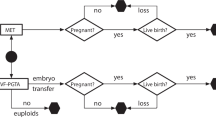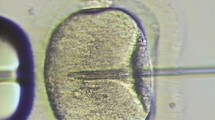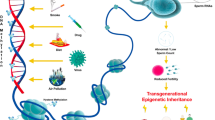Abstract
Purpose
Idiopathic recurrent pregnancy loss (RPL) is a multifactorial reproductive disorder where an impaired control of apoptosis is likely involved. Triggering the cell death mechanism occurs in a spatiotemporal manner and is strongly related to a healthy pregnancy. Single nucleotide polymorphisms (SNPs) at the regulatory regions of genes are known to influence the expression patterns of apoptosis-related molecules.
Methods
A total of 296 unrelated female Brazilian patients were evaluated for clinical-demographic variables and genetic factors: 140 women who had experienced an unexplained RPL (with at least two consecutive abortions) and 156 healthy multiparous women. In all patients, six SNPs were evaluated in genes of apoptosis-related pathways: FAS (rs2234767, rs1800682), FAS-L (rs763110, rs5030772), BAX (rs4645878), and BCL-2 (rs2279115) by PCR followed by a restriction fragment length polymorphism (RFLP)-based analysis.
Results
The BAX-248GA genotype is independently associated with idiopathic RPL [adjusted OR = 0.30, 95% CI 0.13–0.70, P = 0.005] susceptibility. In the same multivariate model, the variables ethnicity, smoking, and alcohol consumption were statistically associated with RPL susceptibility (P < 0.05). No association with RPL susceptibility was reported for the remaining SNPs.
Conclusion
Our study is the first to evaluate the role of the main SNPs from both the extrinsic and intrinsic apoptosis pathways in RPL susceptibility. The association of BAX-248G/A with RPL susceptibility suggests that maternal predisposition for RPL has an essential contribution from genes involved in the delicate balance of endometrium cell turnover (cell death/proliferation). Therefore, apoptotic genes may represent promising targets for future studies on healthy pregnancies and the spectrum of pregnancy disorders.
Similar content being viewed by others
References
Practice Committee of the American Society for Reproductive Medicine. Evaluation and treatment of recurrent pregnancy loss: a committee opinion. Fertil Steril. 2012;98:1103–11.
Rai R, Regan L. Recurrent miscarriage. Lancet. 2006;368:601–11.
Christiansen OB. Research methodology in recurrent pregnancy loss. Obstet Gynecol Clin N Am. 2014;41:19–39.
Toth B, Jeschke U, Rogenhofer N, Scholz C, Würfel W, Thaler CJ, et al. Recurrent miscarriage: current concepts in diagnosis and treatment. J Reprod Immunol. 2010;85:25–32.
Shahine L, Lathi R. Recurrent pregnancy loss. Obstet Gynecol Clin N Am. 2015;42:117–34.
Aghaeepour N, Ganio EA, Mcilwain D, Tsai AS, Tingle M, Van Gassen S, et al. An immune clock of human pregnancy. Sci Immunol. 2017;1:2.
Diemert A, Arck PC. Pregnancy around the clock. Trends Mol Med. 2018;24:1–3.
Choi H-K, Choi BC, Lee S-H, Kim JW, Cha KY, Baek K-H. Expression of angiogenesis- and apoptosis-related genes in chorionic villi derived from recurrent pregnancy loss patients. Mol Reprod Dev. 2003;66:24–31.
Baek K-H. Aberrant gene expression associated with recurrent pregnancy loss. Mol Hum Reprod. 2004;10:291–7.
Sõber S, Rull K, Reiman M, Ilisson P, Mattila P, Laan M. RNA sequencing of chorionic villi from recurrent pregnancy loss patients reveals impaired function of basic nuclear and cellular machinery. Sci Rep. 2016;6:38439.
Lee J, Oh J, Choi E, Park I, Han C, Kim DH, et al. Differentially expressed genes implicated in unexplained recurrent spontaneous abortion. Int J Biochem Cell Biol. 2007;39:2265–77.
Krieg SA, Fan X, Hong Y, Sang Q-X, Giaccia A, Westphal LM, et al. Global alteration in gene expression profiles of deciduas from women with idiopathic recurrent pregnancy loss. Mol Hum Reprod. 2012;18:442–50.
Wei D, Wu Q, Shi H. Apoptosis and p53 expression in the placental villi of females with unexplained recurrent spontaneous abortion. Exp Ther Med. 2014;7:191–4.
Oreshkova T, Dimitrov R, Mourdjeva M. A cross-talk of decidual stromal cells, trophoblast, and immune cells: a prerequisite for the success of pregnancy. Am J Reprod Immunol. 2012;68:366–73.
Galluzzi L, Vitale I, Aaronson SA, Abrams JM, Adam D, Agostinis P, et al. Molecular mechanisms of cell death: recommendations of the nomenclature committee on cell death 2018. Cell Death Differ. 2018;25:486–541.
Peter ME, Hadji A, Murmann AE, Brockway S, Putzbach W, Pattanayak A, et al. The role of CD95 and CD95 ligand in cancer. Cell Death Differ. 2015;22:549–59.
Murakoshi H, Matsuo H, Laoag-Fernandez JB, Samoto T, Maruo T. Expression of Fas/Fas-ligand, Bcl-2 protein and apoptosis in extravillous trophoblast along invasion to the decidua in human term placenta. Endocr J. 2003;50:199–207.
Niederkorn JY. See no evil, hear no evil, do no evil: the lessons of immune privilege. Nat Immunol. 2006;7:354–9.
Robinson R, Hsu CD, Chesebro AL, Nguyen J, Ali N, Maramreddy H, et al. A single-nucleotide polymorphism (-670) of the maternal Fas gene is associated with intrauterine growth restriction. Am J Obstet Gynecol. 2009;201:620.e1–4.
Ciarmela P, Boschi S, Bloise E, Marozio L, Benedetto C, Castellucci M, et al. Polymorphisms of FAS and FAS ligand genes in preeclamptic women. Eur J Obstet Gynecol Reprod Biol. 2010;148:144–6.
Nair RR, Khanna A, Singh K. Association of FAS-1377 G>A and FAS-670 A>G functional polymorphisms of FAS gene of cell death pathway with recurrent early pregnancy loss risk. J Reprod Immunol. 2012;93:114–8.
Banzato PCA, Daher S, Traina É, Torloni MR, Gueuvoghlanian-Silva BY, Puccini RF, et al. FAS and FAS-L genotype and expression in patients with recurrent pregnancy loss. Reprod Sci. 2013;20:1111–5.
Nasr AS, Abdel Aal AA, Soliman A, Setohy KAAEL, Shehata MF. FAS and FAS ligand gene polymorphisms in Egyptian females with preeclampsia. J Reprod Immunol. 2014;104–105:63–7.
Glesse N, Vianna P, Paim LMG, Matte MCC, Aguiar AKK, Palhano PL, et al. Evaluation of polymorphic variants in apoptotic genes and their role in susceptibility and clinical progression to systemic lupus erythematosus. Lupus. 2017;26:746–55.
Raguema N, Zitouni H, Ben Ali Gannoun M, Benletaifa D, Almawi W, Mahjoub T, et al. FAS A-670G and Fas ligand IVS2nt A 124G polymorphisms are significantly increased in women with pre-eclampsia and may contribute to HELLP syndrome: a case-controlled study. BJOG. 2018;125:1758–64.
Masoumi E, Tavakkol-Afshari J, Nikpoor AR, Ghaffari-Nazari H, Tahaghoghi-hajghorbani S, Jalali SA. Relationship between Fas and Fas ligand gene polymorphisms and pre-eclampsia. J Obstet Gynaecol Res. 2016;42:1272–8.
Han AR, Choi YM, Hong MA, Kim JJ, Lee SK, Yang KM, et al. Fas and FasL genetic polymorphisms in women with recurrent pregnancy loss: a case-control study. Hum Fertil. 2018:1–6.
Huang QR, Morris D, Manolios N. Identification and characterisation of polymorphisms in the promoter region of the human Apo-1/Fas (CD95) gene. Mol Immunol. 1997;34:577–82.
Sibley K, Rollinson S, Allan JM, Smith AG, Law GR, Roddam PL, et al. Functional FAS promoter polymorphisms are associated with increased risk of acute myeloid leukemia. Cancer Res. 2003;63:4327–30.
Wu J, Metz C, Xu X, Abe R, Gibson AW, Edberg JC, et al. A novel polymorphic CAAT/enhancer-binding protein beta element in the FasL gene promoter alters Fas ligand expression: a candidate background gene in African American systemic lupus erythematosus patients. J Immunol. 2003;170:132–8.
Galluzzi L, Kepp O, Trojel-Hansen C, Kroemer G. Mitochondrial control of cellular life, stress, and death. Circ Res. 2012;111:1198–207.
Hao Z, Duncan GS, Chang CC, Elia A, Fang M, Wakeham A, et al. Specific ablation of the apoptotic functions of cytochrome c reveals a differential requirement for cytochrome c and Apaf-1 in apoptosis. Cell. 2005;121:579–91.
Marie Hardwick J, Soane L. Multiple functions of BCL-2 family proteins. Cold Spring Harb Perspect Biol. 2013;5:a008722.
Nückel H, Frey UH, Bau M, Sellmann L, Stanelle J, Dürig J, et al. Association of a novel regulatory polymorphism (-938C>A) in the BCL2 gene promoter with disease progression and survival in chronic lymphocytic leukemia. Blood. 2007;109:290–7.
Sahu SK, Choudhuri T. Lack of association between Bax promoter (-248G>A) single nucleotide polymorphism and susceptibility towards cancer: evidence from a meta-analysis. PLoS One. 2013;8(10):e77534.
Feng Y, Chen X, Zheng Y, Liu Q, Chen H, Cai Y, et al. Prognostic value and susceptibility of BAX rs4645878 polymorphism in cancer. Medicine (Baltimore). 2018;97:e11591.
Skogsberg Å, Tobin G, Kröber A, Kienle D, Thunberg U, Åleskog A, et al. The G(-248)A polymorphism in the promoter region of the Bax gene does not correlate with prognostic markers or overall survival in chronic lymphocytic leukemia. Leukemia. 2006;20:77–81.
Moshynska O, Sankaran K, Saxena A. Molecular detection of the G(-248)A BAX promoter nucleotide change in B cell chronic lymphocytic leukaemia. Mol Pathol. 2003;56:205–9.
Starczynski J, Pepper C, Pratt G, Hooper L, Thomas A, Milligan D, et al. Common polymorphism G(-248)A in the promoter region of the bax gene results in significantly shorter survival in patients with chronic lymphocytic leukemia once treatment is initiated. J Clin Oncol. 2005;23:1514–21.
Fegan C, Starczynski J, Pratt G, Pepper C. The role of the bax gene polymorphism G(-248)A in chronic lymphocytic leukemia. Leukemia. 2006;20:1460–1.
Shang W, Shu M-M, Liu M, Wang A-M, Lv L-B, Zhao Y, et al. Elevated expressions of p53, CDKNA1, and Bax in placental villi from patients with recurrent spontaneous abortion. Eur Rev Med Pharmacol Sci. 2013;17:3376–80.
Little J, Higgins JP, Ioannidis JP, Moher D, Gagnon F, von Elm E, et al. STrengthening the REporting of Genetic Association Studies (STREGA)—an extension of the STROBE statement. PLoS Med. 2009;3:6:e22.
Lahiri DK, Numberger JI. A rapid non-enzymatic method for the preparation of HMW DNA from blood for RFLP studies. Nucleic Acids Res. 1991;19:5444.
Sun T, Miao X, Zhang X, Tan W, Xiong P, Lin D. Polymorphisms of death pathway genes FAS and FASL in esophageal squamous-cell carcinoma. J Natl Cancer Inst. 2004;96:1030–6.
Zhang Z, Wang L-E, Sturgis EM, El-Naggar AK, Hong WK, Amos CI, et al. Polymorphisms of FAS and FAS ligand genes involved in the death pathway and risk and progression of squamous cell carcinoma of the head and neck. Clin Cancer Res. 2006;12:5596–602.
Zhang N, Li X, Tao K, Jiang L, Ma T, Yan S, et al. BCL-2 (-938C > A) polymorphism is associated with breast cancer susceptibility. BMC Med Genet. 2011;12:48.
Rodriguez S, Gaunt TR, Day INM. Hardy-Weinberg equilibrium testing of biological ascertainment for Mendelian randomization studies. Am J Epidemiol. 2009;169:505–14.
Barrett JC, Fry B, Maller J, Daly MJ. Haploview: analysis and visualization of LD and haplotype maps. Bioinformatics. 2005;21:263–5.
Kroeff LR, Mengue SS, Schmidt MI, Duncan BB, Favaretto ALF, Nucci LB. Fatores associados ao fumo em gestantes avaliadas em cidades brasileiras. Rev Saude Publica. 2004;38:261–7.
Ruiz-Linares A, Adhikari K, Acuña-Alonzo V, Quinto-Sanchez M, Jaramillo C, Arias W, et al. Admixture in Latin America: geographic structure, phenotypic diversity and self-perception of ancestry based on 7,342 individuals. PLoS Genet. 2014;10:e1004572.
Gilbert-Diamond D, Moore JH. Analysis of gene-gene interactions. Curr Protoc Hum Genet. 2011;1:Unit1.14.
Kalish RB, Nguyen DP, Vardhana S, Gupta M, Perni SC, Witkin SS. A single nucleotide A>G polymorphism at position -670 in the Fas gene promoter: relationship to preterm premature rupture of fetal membranes in multifetal pregnancies. Am J Obstet Gynecol. 2005;192:208–12.
Sezgin M, Barlas IÖ, Yildir S, Türköz G, Ankarali HÇ, Şahin G, et al. Apoptosis-related Fas and FasL gene polymorphisms’ associations with knee osteoarthritis. Rheumatol Int. 2013;33:2039–43.
Jaslow CR, Carney JL, Kutteh WH. Diagnostic factors identified in 1020 women with two versus three or more recurrent pregnancy losses. Fertil Steril. 2010;93:1234–43.
Bhattacharya S, Townend J, Bhattacharya S. Recurrent miscarriage: are three miscarriages one too many? Analysis of a Scottish population-based database of 151,021 pregnancies. Eur J Obstet Gynecol Reprod Biol. 2010;150:24–7.
Rull K, Nagirnaja L, Laan M. Genetics of recurrent miscarriage: challenges, current knowledge, future directions. Front Genet. 2012;3:34.
Krieg SA, Shahine LK, Lathi RB. Environmental exposure to endocrine-disrupting chemicals and miscarriage. Fertil Steril. 2016;106:941–7.
Conforti A, Mascia M, Cioffi G, De Angelis C, Coppola G, De Rosa P, et al. Air pollution and female fertility: a systematic review of literature. Reprod Biol Endocrinol. 2018;16:117.
Mukherjee S, Velez Edwards DR, Baird DD, Savitz DA, Hartmann KE. Risk of miscarriage among black women and white women in a U.S. Prospective Cohort Study. Am J Epidemiol. 2013;177:1271–8.
Harb HM, Al-rshoud F, Dhillon R, Harb M, Coomarasamy A. Ethnicity and miscarriage: a large prospective observational study and meta-analysis. Fertil Steril. 2014;102:e81.
Kesmodel U, Wisborg K, Olsen SF, Henriksen TB, Secher NJ. Moderate alcohol intake in pregnancy and the risk of spontaneous abortion. Alcohol Alcohol. 2002;37:87–92.
Lindbohm M-L, Sallmén M, Taskinen H. Effects of exposure to environmental tobacco smoke on reproductive health. Scand J Work Environ Health. 2002;28(Suppl 2):84–96.
Wikström A-K, Stephansson O, Cnattingius S. Tobacco use during pregnancy and preeclampsia risk. Hypertension. 2010;55:1254–9.
Jeyabalan A, Powers RW, Durica AR, Harger GF, Roberts JM, Ness RB. Cigarette smoke exposure and angiogenic factors in pregnancy and preeclampsia. Am J Hypertens. 2008;21:943–7.
Karumanchi SA, Levine RJ. How does smoking reduce the risk of preeclampsia? Hypertension. 2010;55:1100–1.
Kawashima A, Koide K, Ventura W, Hori K, Takenaka S, Maruyama D, et al. Effects of maternal smoking on the placental expression of genes related to angiogenesis and apoptosis during the first trimester. Zenclussen AC, editor. PLoS One. 2014;9:e106140.
Miyashita T, Reed JC. Tumor suppressor p53 is a direct transcriptional activator of the human bax gene. Cell. 1995;80:293–9.
Chen K, Hu Z, Wang LE, Sturgis EM, El-naggar AK, Zhang W, et al. Single-nucleotide polymorphisms at the TP53-binding or responsive promoter regions of BAX and BCL2 genes and risk of squamous cell carcinoma of the head and neck. Carcinogenesis. 2007;28:2008–12.
Fraga LR, Dutra CG, Boquett JA, Vianna FSL, Gonçalves RO, Paskulin DD, et al. p53 signaling pathway polymorphisms associated to recurrent pregnancy loss. Mol Biol Rep. 2014;41:1871–7.
Vaskivuo TE, Stenbäck F, Karhumaa P, Risteli J, Dunkel L, Tapanainen JS. Apoptosis and apoptosis-related proteins in human endometrium. Mol Cell Endocrinol. 2000;165:75–83.
De Falco M, De Luca L, Acanfora F, Cavallotti I, Cottone G, Laforgia V, et al. Alteration of the Bcl-2:Bax ratio in the placenta as pregnancy proceeds. Histochem J. 2001;33:421–5.
Funding
This study was supported by Fundação de Amparo à Pesquisa do Estado do Rio Grande do Sul (grant no. 14/2253-2 PqG) and Conselho Nacional de Desenvolvimento Científico e Tecnológico (grant nos. 473115/2011-5 and 305839/2015-2).
Author information
Authors and Affiliations
Corresponding author
Ethics declarations
This study was approved by the Research Ethics Committee of the HCPA (HCPA-CEP-CPPG) under protocol number #11-242. We obtained written, informed consent according to the Declaration of Helsinki from all individual participants included in this study.
Conflict of interest
The authors declare that they have no conflict of interest.
Additional information
Publisher’s note
Springer Nature remains neutral with regard to jurisdictional claims in published maps and institutional affiliations.
Rights and permissions
About this article
Cite this article
Michita, R.T., Zambra, F.M.B., Fraga, L.R. et al. The role of FAS, FAS-L, BAX, and BCL-2 gene polymorphisms in determining susceptibility to unexplained recurrent pregnancy loss. J Assist Reprod Genet 36, 995–1002 (2019). https://doi.org/10.1007/s10815-019-01441-w
Received:
Accepted:
Published:
Issue Date:
DOI: https://doi.org/10.1007/s10815-019-01441-w




